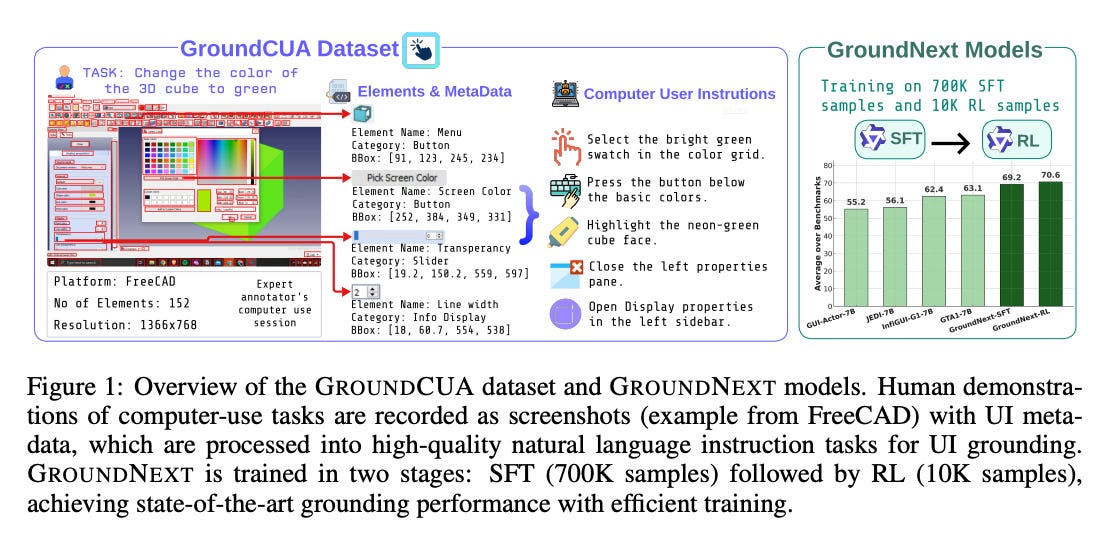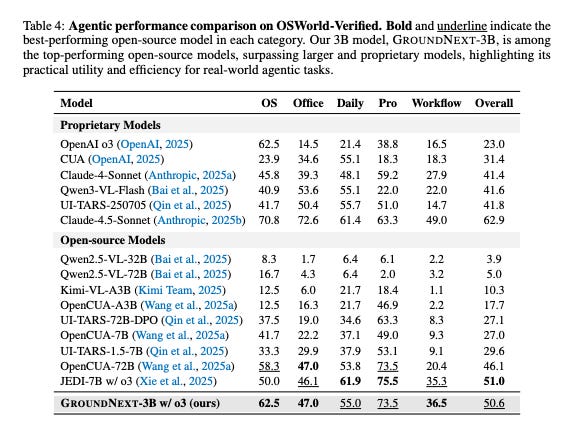Why This New AI Paper Unlocks the Trillion-Dollar Market for Autonomous Agents
We’re all waiting for the “Jarvis” moment.
We’ve been promised a future where we can simply talk to our computers, and they’ll do things for us. Not just answer questions like a search engine or write an email like a clever intern, but actually perform the work.
“Hey, take the final sales numbers from that email, update the Q3 forecast in our finance portal, build a summary slide, and add it to the board deck. Let me know when it’s done.”
This is the multi-trillion-dollar promise of autonomous AI agents. And for the past two years, despite the explosion in Large Language Models, this promise has remained stubbornly out of reach.
We’ve built AIs that are “book smart” but “computer dumb.”
An LLM can write a brilliant strategy memo on market entry, but it can’t actually open PowerPoint, find the right template, and paste in the text. This is the “last mile” problem, and it’s a canyon, not a gap.
In the AI industry, we call this the “grounding” problem. It’s the challenge of reliably connecting a natural language instruction (”click the save icon”) to the exact corresponding element on a high-resolution, cluttered computer screen (”that specific 12x12 pixel icon at coordinates [28, 942], not the 50 other icons that look just like it”).
If an agent fails this “last click” even 1% of the time, the entire task fails.
You can’t build a reliable product on that. This single bottleneck has stalled the entire field of enterprise automation.
Until now, we’ve tried to solve this with brute force. We’re in a “data arms race,” scraping petabytes of data from the web, generating millions of synthetic UIs, and feeding our models a diet of digital garbage. We’ve been training our models on “simplified screens” that don’t “represent genuine desktop complexity” or using automated labeling tools that are “incomplete or inconsistent”.
The result is what you’d expect: garbage in, garbage out.
The models we’ve built are brittle. As the research shows, when grounding fails, “the plan quickly veers off course... and tasks ultimately fail”. It’s an endless, expensive cycle of scaling up junk data to get a result that’s still just 90% reliable, which in the real world means 100% useless.
Then, last week, a preprint from a joint team at Mila, Université de Montréal, McGill, and ServiceNow Research landed. It’s not just another model. It’s a new philosophy. And it’s the blueprint for how we’ll actually build the next generation of autonomous agents.
The Unlock: Trading 10 Million Blurry Invoices for One Week with the CFO
The paper, “Grounding Computer Use Agents on Human Demonstrations” isn’t subtle. It’s a direct challenge to the “bigger is better” data scaling dogma.
The researchers identified the core problem: our training data is garbage. And they posed a simple, brilliant question: What if, instead of feeding our models 10 million low-quality, machine-generated screenshots, we fed them just 50,000 perfect, human-expert-annotated ones?
What if we traded data quantity for data quality?
The old way was like trying to teach an intern to be a CFO by having them read every blurry, mislabeled, coffee-stained invoice in the company’s 50-year archive. It’s all noise. You’ll get an intern who is very good at identifying coffee stains, not at financial strategy.
The new approach is like giving that intern a one-week apprenticeship, shadowing the actual CFO during the 10 most critical tasks of the quarter: the earnings call prep, the M&A valuation, the budget review. You’re not capturing random noise; you’re capturing expert, high-signal, contextual interaction.
This is precisely what the team did. They built a new, foundational asset.
It’s called GROUNDCUA. And it’s the dataset I’ve been waiting for.
Here’s how they built it, and as a builder, this is the part that gets me excited:
They Hired Human Experts: They didn’t scrape. They partnered with a data-labeling firm and had trained annotators actually perform over 10,000 real-world tasks.
They Used Real, Complex Software: This wasn’t “click the button” on a test website. They used 87 different, real-world desktop applications. We’re talking complex, professional-grade software like FreeCAD, Blender, GIMP, LibreOffice, and VSCode. The exact kind of high-density, high-complexity apps where agents fail today.
They Captured Dense, Rich Data: From these 10,000+ video demonstrations, they extracted 56,000 keyframes (screenshots) and then densely annotated every single visible UI element in each one.
The result is an asset that is an order of magnitude better than anything that has come before.
We’re talking 3.56 million human-verified annotations. The average GROUNDCUA screenshot has 64 annotations on it, compared to 9 or 11 for older datasets.
Talk about data density!
It captures the true pixel-dense nature of desktop software, including high-resolution screens up to 7M pixels and the tiny icons and controls (averaging just 0.13% of the image area) that automated tools always miss.
This isn’t a dataset. It’s a curriculum. It doesn’t just show what a screen looks like; it shows what an expert does with it.
The “Aha!” Moment
So, they built the “gourmet” dataset. The next step was to see if the model could taste the difference.
They trained a new family of models called GROUNDNEXT (at 3B and 7B parameter scales) on this new, high-quality data.
The punchline is staggering.
GROUNDNEXT achieves state-of-the-art results using less than one-tenth (1/10th) the training data of its biggest competitors.
The team used just 700,000 instruction samples from GROUNDCUA. The prior SOTA model, JEDI, was trained on 9 million datapoints. GROUNDNEXT didn’t just get a 10% improvement; it got a 12x+ improvement in data efficiency while also beating JEDI on absolute performance.
This is the “Aha!” moment. It proves, decisively, that the bottleneck was never the model size. It was the data quality.
But here’s the chart that made me jump out of my chair. It’s Table 4, the “Agentic Performance” test. This isn’t just a simple “click the button” benchmark. This is a real-world, multi-step task evaluation on the OSWorld benchmark. This is the test that matters.
The results are a market-shock:
The tiny
GROUNDNEXT-3B(3-billion parameter) model......achieved an overall score (50.6) that was statistically identical to the much larger JEDI-7B (7-billion parameter) model (51.0).
...and it crushed other 3B models, but more importantly, it outperformed giant models 20x its size, like the OpenCUA-72B (72-billion parameter) model (46.1).
...it even beat proprietary, closed-source APIs like Claude-4-Sonnet (41.4).
This is the asymmetric opportunity. A small, efficient model, when fed a diet of expert-quality data, can outperform a monster model fed on digital junk.
The paper’s conclusion is a mic drop: “high-quality, expert-driven datasets” are the critical factor. “High-quality data drives reliable desktop grounding more effectively than sheer data volume.”.
Friends: in addition to the 17% discount for becoming annual paid members, we are excited to announce an additional 10% discount when paying with Bitcoin. Reach out to me, these discounts stack on top of each other!
Thank you for helping us accelerate Life in the Singularity by sharing.
I started Life in the Singularity in May 2023 to track all the accelerating changes in AI/ML, robotics, quantum computing and the rest of the technologies accelerating humanity forward into the future. I’m an investor in over a dozen technology companies and I needed a canvas to unfold and examine all the acceleration and breakthroughs across science and technology.
Our brilliant audience includes engineers and executives, incredible technologists, tons of investors, Fortune-500 board members and thousands of people who want to use technology to maximize the utility in their lives.
To help us continue our growth, would you please engage with this post and share us far and wide?! 🙏



